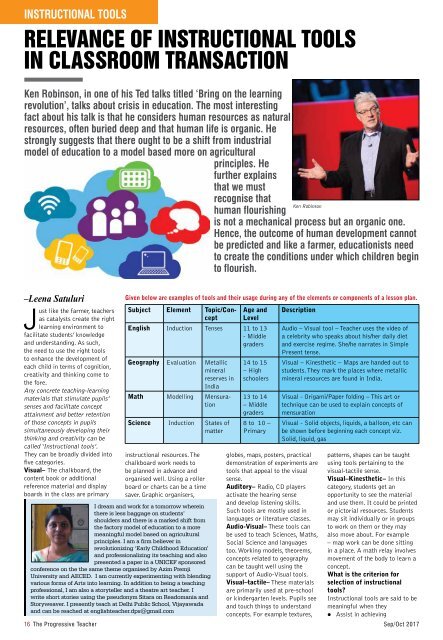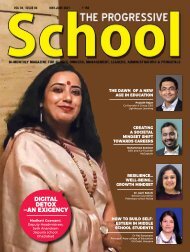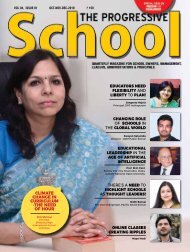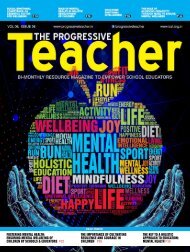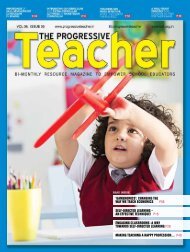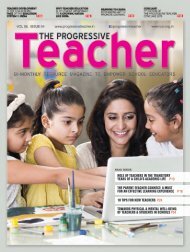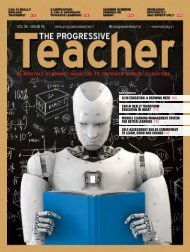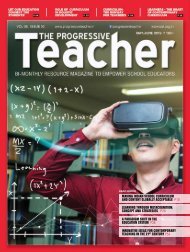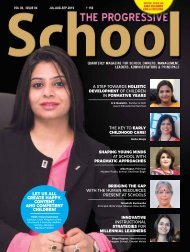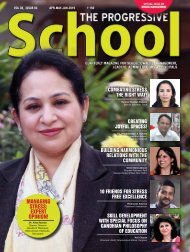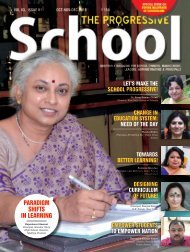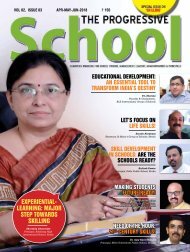The Progressive Teacher Vol 04 Issue 04
This issue of The Progressive Teacher focuses on "New Instructional Tools ". In this edition, articles explore the changes brought by technological advancements in the tools of educational instruction. Enjoy reading!
This issue of The Progressive Teacher focuses on "New Instructional Tools ". In this edition, articles explore the changes brought by technological advancements in the tools of educational instruction. Enjoy reading!
You also want an ePaper? Increase the reach of your titles
YUMPU automatically turns print PDFs into web optimized ePapers that Google loves.
instructional tools<br />
Relevance of Instructional Tools<br />
in Classroom Transaction<br />
Ken Robinson, in one of his Ted talks titled ‘Bring on the learning<br />
revolution’, talks about crisis in education. <strong>The</strong> most interesting<br />
fact about his talk is that he considers human resources as natural<br />
resources, often buried deep and that human life is organic. He<br />
strongly suggests that there ought to be a shift from industrial<br />
model of education to a model based more on agricultural<br />
principles. He<br />
further explains<br />
that we must<br />
recognise that<br />
Ken Robinson<br />
human flourishing<br />
is not a mechanical process but an organic one.<br />
Hence, the outcome of human development cannot<br />
be predicted and like a farmer, educationists need<br />
to create the conditions under which children begin<br />
to flourish.<br />
–Leena Satuluri<br />
Just like the farmer, teachers<br />
as catalysts create the right<br />
learning environment to<br />
facilitate students’ knowledge<br />
and understanding. As such,<br />
the need to use the right tools<br />
to enhance the development of<br />
each child in terms of cognition,<br />
creativity and thinking come to<br />
the fore.<br />
Any concrete teaching-learning<br />
materials that stimulate pupils’<br />
senses and facilitate concept<br />
attainment and better retention<br />
of those concepts in pupils<br />
simultaneously developing their<br />
thinking and creativity can be<br />
called ‘Instructional tools’.<br />
<strong>The</strong>y can be broadly divided into<br />
five categories.<br />
Visual– <strong>The</strong> chalkboard, the<br />
content book or additional<br />
reference material and display<br />
boards in the class are primary<br />
instructional resources. <strong>The</strong><br />
chalkboard work needs to<br />
be planned in advance and<br />
organised well. Using a roller<br />
board or charts can be a time<br />
saver. Graphic organisers,<br />
I dream and work for a tomorrow wherein<br />
there is less baggage on students’<br />
shoulders and there is a marked shift from<br />
the factory model of education to a more<br />
meaningful model based on agricultural<br />
principles. I am a firm believer in<br />
revolutionizing ‘Early Childhood Education’<br />
and professionalizing its teaching and also<br />
presented a paper in a UNICEF sponsored<br />
conference on the the same theme organised by Azim Premji<br />
University and AECED. I am currently experimenting with blending<br />
various forms of Arts into learning. In addition to being a teaching<br />
professional, I am also a storyteller and a theatre art teacher. I<br />
write short stories using the pseudonym Sitara on Readomania and<br />
Storyweaver. I presently teach at Delhi Public School, Vijayawada<br />
and can be reached at englishteacher.dps@gmail.com<br />
Given below are examples of tools and their usage during any of the elements or components of a lesson plan.<br />
Subject Element Topic/Concept<br />
Age and<br />
Level<br />
English Induction Tenses 11 to 13<br />
- Middle<br />
graders<br />
Geography Evaluation Metallic<br />
mineral<br />
reserves in<br />
India<br />
Math Modelling Mensuration<br />
Science Induction States of<br />
matter<br />
14 to 15<br />
– High<br />
schoolers<br />
13 to 14<br />
– Middle<br />
graders<br />
8 to 10 –<br />
Primary<br />
Description<br />
globes, maps, posters, practical<br />
demonstration of experiments are<br />
tools that appeal to the visual<br />
sense.<br />
Auditory– Radio, CD players<br />
activate the hearing sense<br />
and develop listening skills.<br />
Such tools are mostly used in<br />
languages or literature classes.<br />
Audio-Visual– <strong>The</strong>se tools can<br />
be used to teach Sciences, Maths,<br />
Social Science and languages<br />
too. Working models, theorems,<br />
concepts related to geography<br />
can be taught well using the<br />
support of Audio-Visual tools.<br />
Visual–tactile– <strong>The</strong>se materials<br />
are primarily used at pre-school<br />
or kindergarten levels. Pupils see<br />
and touch things to understand<br />
concepts. For example textures,<br />
Audio – Visual tool – <strong>Teacher</strong> uses the video of<br />
a celebrity who speaks about his/her daily diet<br />
and exercise regime. She/he narrates in Simple<br />
Present tense.<br />
Visual – Kinesthetic – Maps are handed out to<br />
students. <strong>The</strong>y mark the places where metallic<br />
mineral resources are found in India.<br />
Visual - Origami/Paper folding – This art or<br />
technique can be used to explain concepts of<br />
mensuration<br />
Visual - Solid objects, liquids, a balloon, etc can<br />
be shown before beginning each concept viz.<br />
Solid, liquid, gas<br />
patterns, shapes can be taught<br />
using tools pertaining to the<br />
visual-tactile sense.<br />
Visual–Kinesthetic– In this<br />
category, students get an<br />
opportunity to see the material<br />
and use them. It could be printed<br />
or pictorial resources. Students<br />
may sit individually or in groups<br />
to work on them or they may<br />
also move about. For example<br />
– map work can be done sitting<br />
in a place. A math relay involves<br />
movement of the body to learn a<br />
concept.<br />
What is the criterion for<br />
selection of instructional<br />
tools?<br />
Instructional tools are said to be<br />
meaningful when they<br />
• Assist in achieving<br />
16 <strong>The</strong> <strong>Progressive</strong> <strong>Teacher</strong> Sep/Oct 2017


